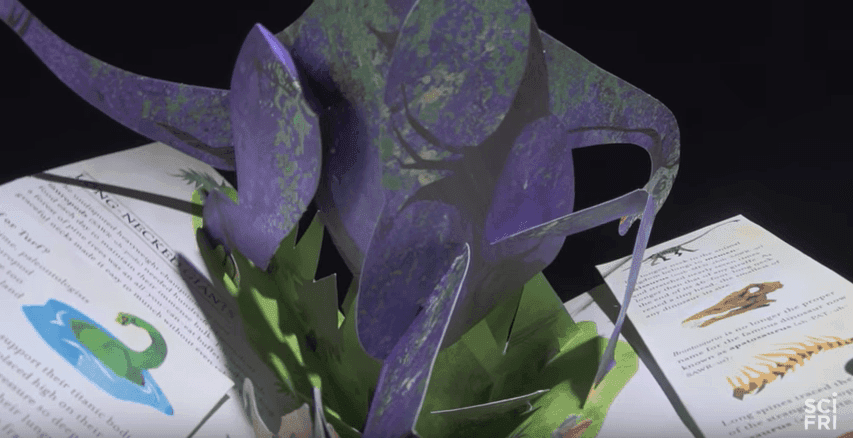Watch the artistry and engineering that goes into making pop-up books
When artist Matthew Reinhart gets an idea for a children’s book, he scribbles a note to himself about what he wants the illustrations to do. Things like, “T-Rex head bites reader.”
“That’s it,” Reinhart says. “I don’t know how it’s going to happen with all the engineering. I just know that’s what I want to happen.”
Reinhart isn’t talking about an illustration so realistic it seems to leap off the page. He’s a pop-up book designer, and some of his creations can extend to nearly two feet in height, while others are so well-engineered that they can animate entire scenes of a story.
Video producer Luke Groskin bought one of Reinhart’s books for his son several years ago. It’s not a moment that he’ll soon forget.
“I opened it, and this T-Rex just lunged out at my son and I,” Groskin says. “And it really does lunge about a foot off the page. It’s got a full head. It’s just a marvel of engineering that this is just paper.”
Groskin visited Reinhart’s studio in New York to learn more about how he makes his pop-ups. What startled him was how “normal” the workspace was.
“It actually looks like a standard artist’s studio. You know, he’s got a lot of tape — a lot of tape — a lot of paper, just scissors and an X-Acto blade knife. He’s got a computer that he does some compositing work on, but for the most part, it’s all handcrafted. And of course, his walls are just lined with Transformers. He’s obsessed with Transformers. “
But with simple materials, Reinhart can create paper sculptures with a surprising number of moving parts. One of the mechanisms he relies on is the “v-fold,” a little folded triangle of paper securing a pop-up to the page, allowing it to move in an arc as the page is opened.
By varying the angle of the v-folds behind each component, Reinhart can adjust when and how each piece will appear as the page is turned. Some of Reinhart’s pop-ups use as many as 20 v-folds, many of them building off of each other to make movement possible.
“The wider the v, the longer that that ‘pop’ will take,” Groskin says. “The narrower the v, the quicker it will actually take. And so in that regard, you can actually program or engineer different timings of different pops.”
Reinhart’s pop-up of Princess Leia from “Star Wars,” which shows the moment when Princess Leia lowers her hood, is a good example. It might have been easier for Reinhart to build a pop-up where Leia sheds the hood immediately, focusing the reader’s attention on her face. But he didn’t, and now the pop-up is one of Groskin’s favorites.
“Instead, you open a page, and you can see this woman,” he says. “You know, this iconic image of the woman with her white cloak, and she’s not fully revealed quite yet. And then after you reach about 150 degrees, that last 30 degrees, that’s when the hood comes down.”
When it comes down to it, Reinhart’s books may be designed for children, but they’re “magical” for readers of any age.
“They really do capture the wonder of, you know, reading a book,” Groskin says. “And [of] being kind of surprised. You never know what’s going to happen when you open one of these [pop-ups].”
This article is based on an interview that aired on PRI’s Science Friday.
We want to hear your feedback so we can keep improving our website, theworld.org. Please fill out this quick survey and let us know your thoughts (your answers will be anonymous). Thanks for your time!
